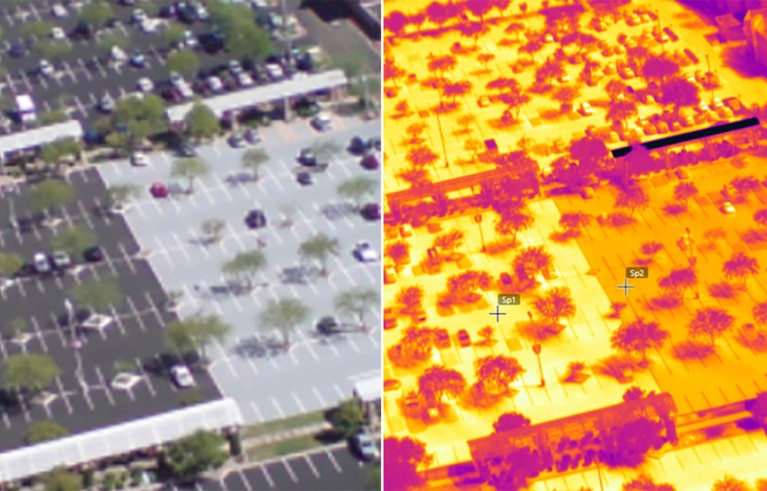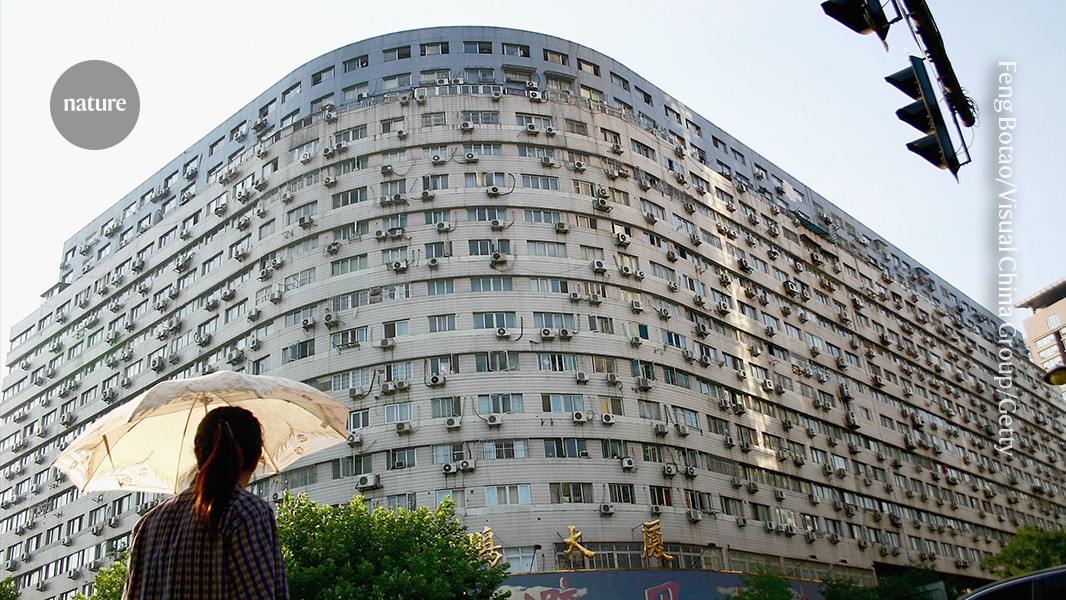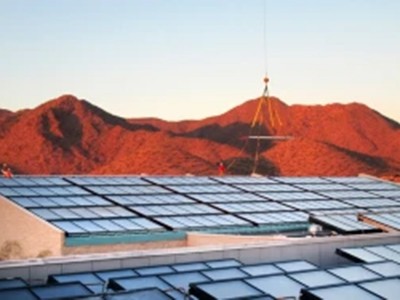It’s time to brace for record-breaking heat. Last year was the hottest on record and 2024 is shaping up to be even more extreme, with the mercury soaring close to 50 °C on days in Nevada, Egypt and Australia. June marked the 13th month in a row of chart-topping temperatures globally. And four consecutive days in July were the hottest in recorded history for the entire planet.
Scorching temperatures spur water shortages, damage crops, strain electricity grids and trigger heat stress and mass mortality — killing close to 500,000 people each year, according to one estimate1. So scientists are working hard to develop innovative ways to cool cities and slash electricity use in the warming world. Advances range from high-efficiency air conditioners to special materials that keep surfaces colder than their surroundings without using electricity.
Researching refrigeration
In most air conditioners and refrigerators, a fluid is compressed to transfer heat from inside the room or appliance to outside. But this process emits greenhouse gases and guzzles energy. Globally, air conditioners and electric fans consume about 20% of the electricity used in buildings, according to the International Energy Agency. And the agency predicts that the amount of energy required for air conditioning around the globe will surge threefold by 2050.
With that in mind, many researchers are working to reduce the amount of energy that air conditioners consume. One potential solution emerged last year, when a team of researchers developed a technology that might make the appliances work much more efficiently2. And it has the added benefit of not relying on environmentally damaging liquid coolants.
‘Electrocaloric’ heat pump could transform air conditioning
Emmanuel Defay, a researcher at the Luxembourg Institute of Science and Technology in Belvaux, and his colleagues built a device that relies on ‘electrocaloric’ cooling. In this process, an electric field is applied to change the position of atoms in an insulating ceramic. Because the field constrains the atoms’ movements, their vibrations increase and are converted into heat, raising the temperature of the material. Fluid carries that heat away to the outside. Once the heat has been removed, the field is shut off and the atoms in the ceramic can move more freely. That causes their vibrations to decrease and the ceramic’s temperature drops, a change that can be used for cooling purposes.
The device was designed in collaboration with the Japanese manufacturing company Murata in Nagaokakyo, which already produces these kinds of ceramics for mobile phones, computers and other hardware. That will help to make the technology scalable, says Defay. But he warns that getting it into products might take time. He hopes that he and his team can work on the first niche cases, such as cooling down batteries in electric cars, within five years. Then, perhaps, they can tackle air conditioning in the next decade.
Game-changing materials
Other components — known as supercool materials — might be able to lower temperatures below ambient conditions without power.
All materials reflect some portion of the sunlight that hits them, and all emit energy as heat. But supercool materials do both extremely well — reflecting most of their incident solar radiation and emitting a lot of their thermal radiation. That makes them cooler than their surrounding temperature.
“These materials are potentially a game-changer,” says David Sailor, director of the School of Geographical Sciences and Urban Planning at Arizona State University in Tempe, who doesn’t develop these technologies but studies how they could be used in urban environments. Not only can they help to cool a building — thus reducing the demand for air conditioning — but they can also cool the outdoor air. “If a surface is always cooler than the air, then that surface is always taking heat out of the air as the air flows over it,” Sailor says. “So it’s actively cooling the urban atmosphere.”
The first supercool material was designed in 2014 when Aaswath Raman, a materials scientist now at the University of California, Los Angeles, was conducting research at Stanford University, also in California. He and his colleagues created a cooling surface that was highly reflective at the visible wavelengths where the Sun’s radiation peaks, and emissive in the mid-infrared3. The latter was key. The atmosphere traps most of the infrared radiation emitted as heat by objects on Earth’s surface. But a specific band of infrared, with wavelengths of 8–13 micrometres, passes straight through the atmosphere and disappears into space. Supercool materials exploit that infrared window.
Mounted on a roof, Raman’s technology — which was made of seven alternating layers of silicon dioxide and hafnium dioxide — stayed 5 °C cooler than the ambient air temperature.

Researchers applied special paint to a car park (left; pale area) in Arizona. An infrared image shows that area was cooler than its surroundings.Credit: Edwin Ramirez/School of Geographical Sciences and Urban Planning, Arizona State University
Since then, the field has exploded. In the laboratory, supercool materials have been built in the form of plastics, metals, paints and even wood.
And scientists are continuing to push them further. In July, researchers at Sichuan University in Chengdu, China, reported that they had freeze-dried a solution of commercially obtained salmon sperm DNA and gelatin to create a supercool aerogel4. When placed outside, the aerogel cooled surfaces to up to 16 °C below the ambient air temperature.
Xianhu Liu, a materials scientist at Zhengzhou University in China, who was not involved in the study, is particularly excited that the material uses less energy and reduces pollutants compared with other supercool materials that use additives, such as metal oxide nanoparticles. The fact that this work used biomass materials also means it’s degradable. “It’s a rare combination of sustainability and energy efficiency,” Liu says.
But Raman doubts the accuracy of the study’s results. The team measured an air temperature 20–30 °C higher than that reported by weather stations for that day and location. “It seems likely that their temperature sensor was exposed to the Sun and heated up,” Raman says.
However, Jian-Wen Ma, the study’s lead researcher, says that he and his team measured the air temperature inside a closed cooling test box, not the external atmospheric temperature4. “There is ongoing debate about cooling test methods,” he says. “The characterization of radiative cooling remains complex and imperfect, and we hope for a unified standard in the future.”
Cool surfaces
In his own research, Raman has moved from supercool materials to a category called cool materials, which are typically engineered to reflect most of their incident solar radiation, but not necessarily tailored to emit most of their thermal radiation.
“You don’t need to do this fancy thing in the infrared, you just need to make it really solar reflective,” he says. That’s because most materials will still emit heat across the entire infrared spectrum and will reach temperatures slightly below those of ambient air if they are reflective enough, Raman says.
Raman has also been working on another type of material for vertical surfaces such as building facades. This is a difficult application because walls face both the sky and the ground, so they absorb heat from Earth during the summer and lose heat to it during the winter.
The supercool materials that send heat to space
Raman’s team found a potential solution. In June, the researchers reported a physical mechanism that relies on a special material to cool or warm walls depending on the season5. The coating achieves this by selectively losing heat towards the sky and gaining much less heat from the ground in the summer. And in the winter, it loses less heat to the ground than a conventional wall does. To boot, the team has found that many low-cost materials have this unique property — including the polypropylene bags used for crisps, or potato chips. The discovery could be a boon for places that don’t have air conditioning, and could improve thermal comfort and even human health, he says.
“I don’t want to advance the perception, especially among architects and engineers, that this is some faraway thing,” Raman says. “I want them to realize there’s a lot of things we can do right away.”
Other researchers are also working on this problem. A report this month by Yuan Yang, a materials scientist at Columbia University in New York City, and his colleagues describes work in which they applied a supercool paint to a corrugated wall — but only to the sides of the wave-like pattern that face the sky. The team then applied a metal that has a low heat absorption to the side facing the ground, ensuring that side did not take up excess heat6. The surface temperature of the wall stayed 2–3 °C cooler than the ambient air temperature. The team is currently looking for funding to support further development.
Other technologies are attempting to cool cities from the ground up. Last September, a team at Arizona State University in Tempe, led by Sailor, partnered with a US company that managed a large shopping centre to deploy and test a reflective ‘cool pavement’. The highly reflective coating is simply a lighter-coloured, asphalt-based seal that can be used instead of the conventional dark coating that is applied every five years or so to maintain the surface. As a test run, the lighter seal was applied to almost 6,000 square metres of the centre’s car park, and the surrounding area was coated with a conventional dark seal — allowing Sailor and his team to compare the two.
The difference was like night and day. In the early afternoon, the surface temperature of the cool pavement was almost 8 °C cooler than the rest of the car park, and the air temperature above it was 0.8 °C cooler, says Sailor, who has not yet published this finding.
Although the latter figure might not seem a noteworthy change, Sailor argues that if you could cool the entire city of Phoenix in Arizona by 0.6 °C, you would reduce energy consumption and water use and even improve human health outcomes. Sailor estimated that the drop in air conditioning alone would save around US$20 million.
Shape-shifting materials
Mohammad Taha, an engineer at the University of Melbourne in Australia, and their team are taking a different approach to cool homes and buildings. Early in 2023, the team described ‘phase-change inks’ consisting of suspended nanoparticles that change phase depending on the temperature, shifting from a superconductor at cool temperatures to a metal at hotter temperatures7.
How heat from the Sun can keep us all cool
That trick allows the material to stay cool or warm, depending on the external temperature. In short, when the material heats up and becomes a metal, it adopts a linear structure that can reflect extra heat. When it cools and becomes a superconductor, the material adopts an insulating zig-zag structure that allows heat in.
In the future, Taha hopes to apply this ink as a window coating. “If you look at the weakest link in a building in terms of heat loss, it’s the windows,” they say. “A building that’s entirely glass can actually feel like a greenhouse on a hot day.” That could change if Taha and their team can apply this ink to windows effectively in the future. Moreover, the researchers can engineer different coatings depending on the season — layering them to keep a building cool during summer and warm during winter.
From lab to cities
It’s not yet clear which of these cooling technologies are likely to have a big impact in future. Many have not left the lab and others have been deployed only in small-scale projects. For that reason, Sailor argues that researchers need to evaluate all new materials carefully before moving forward. “It’s really important that we in the science community — and I take this as one of my responsibilities in evaluating these technologies — focus not just on their strengths, but also on their weaknesses,” he says.
The cool pavement, for example, has a potential drawback in that it reflects radiation upwards. Someone on that pavement when the Sun is high in the sky will feel the reflected radiation from below in addition to that from above. He suggests that the coating would be less suitable in areas such as playgrounds, where individuals might spend a long time on the surface in the middle of the day. A better option would be to use it on street pedestrian crossings, where individuals spend mere seconds, he says.
There are also questions about how well supercool materials will work in a wide variety of climates. If it is cloudy or humid, for example, such materials might be less effective — that’s because water vapour traps the infrared radiation, stopping it from escaping into space8. Raman, however, argues that supercool materials can still perform well in these climates. Even if they can’t cool the air temperature sufficiently, he says, they won’t heat it up either9.
Another unknown is whether consumers will embrace the idea. Even the simple measure of replacing old roofs with lighter, reflective ones has not been widely adopted. As part of his work, Sailor routinely takes an infrared camera up in a helicopter over Phoenix and is always amazed by the number of dark rooftops — despite the benefits of cooler, lighter roofs.
Nonetheless, several cities are testing and deploying various mitigation technologies. Los Angeles, for example, has been adding cool pavements with the goal of increasing cool surfaces there by 30% by 2045.
Mattheos Santamouris, a physicist at the University of New South Wales in Sydney, Australia, and his team have applied similar materials in more than 300 large-scale mitigation projects across the world. In January, his group detailed a multifaceted strategy to cool Riyadh by up to 4.5 °C10. “This is really the champion of the mitigation projects,” Santamouris says. The recommended approach, which Riyadh has started adopting, includes retrofitting buildings with both cool and supercool materials, and doubling the number of irrigated trees.
Although the approach includes a suite of solutions, Santamouris’s team calculated that the addition of supercool materials will have the biggest impact. “The market is increasing tremendously,” Santamouris says about these materials. “There are more and more industrial producers around the world. I think that this is the future.”





